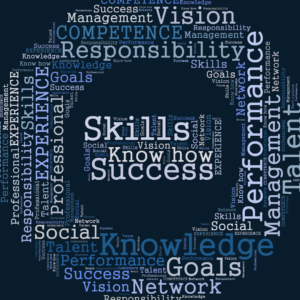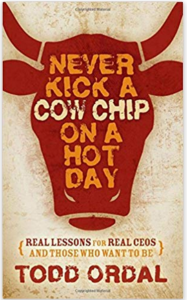“What got you to $10 million bucks in revenue probably won’t get you to $50 million, and I guarantee it won’t get you to a billion. So, your skill sets have to change,” said Todd Ordal.
The CEO role and the internal capabilities required to grow a company are rapidly being redefined. The New CEO is grappling with a:
- Shift from shareholder to stakeholder
- Seismic demographic, ethnic, and gender transference from Baby Boomers to GenXers, Millennials, and GenZers
- Reimagination of physical products to digital products and multiple services
- Recognition that understanding customer behaviors, not transactions are redefining customer relationships,
- Realization that we’re in a Gilded Age where the veneer of everything is great to the Authenticity Age where leaders, consumers, and communities are leveraging social business and corporate social responsibility to solve the challenges we face.
If I had one word to describe Todd Ordal, President of Applied Strategy, it would be Coach. A coach to CEOs for mid-cap companies with revenues in the $50 million to $2 billion range for almost 15 years, he is the former CEO of two medium-size companies: a sporting goods and design wholesale firm and a learning disabilities company. He was also the former Division President of Kinko’s. As Todd notes, he has the scars and the lessons he’s learned along the way that informs how he thinks about the CEO role.
In Part Three of the three-part series, we’ll discuss why Todd Ordal believes CEOs who aren’t thinking about their strategy are poised to miss the market in a crisis and the key lessons he shares from his book, “Never Kick a Cow Chip on a Hot Day: Real Lessons for Real CEOs and Those Who Want to Be.” Read Part 1 and Part 2 of the series.
_____________________________
Carla A. Fleming (Fleming): How do you define the internal capabilities?
 Todd Ordal (Ordal): Internal capabilities have to align with what the market needs. You have to have a clear strategy. Where are we going? How are we going to win in our environment? What resources are required to execute against that? There are usually three or four major competencies you have to have to execute strategy. Then it’s a function of aligning resources against those.
Todd Ordal (Ordal): Internal capabilities have to align with what the market needs. You have to have a clear strategy. Where are we going? How are we going to win in our environment? What resources are required to execute against that? There are usually three or four major competencies you have to have to execute strategy. Then it’s a function of aligning resources against those.
If resources aren’t needed to execute those critical issues, you’re not putting resources where you need them, and you’re not going to execute your strategy. So, it’s a good question. I think you have to constantly revisit it.
Say, do you have the right resources to execute this strategy? And, what people don’t – the second question they don’t ask is – what capabilities do I have in my organization that either I could exploit or frankly I don’t need? They’re being wasted.
Fleming: Why is it you think they don’t ask that question?

Business Results. Photo Credit: Canva.
Todd: Nobody likes to get rid of folks. I have a client who just asked his team, senior team, to cut $20 million bucks out of General and Administrative Expense (G&A) for 2020. They came back to him with about $35 million because they went to their people and said, “What’s not required here? What are we doing that we don’t need to do?” All of a sudden, this stuff started to surface. This is a very old company; it’s been around for a long time. Departments exist that were needed 10 years ago, aren’t needed and they’re still there.
I have another client, who’s a friend as well, who’s been in multiple CEO roles and he’s a hardass. He’s a good guy. People love working for him. But he is a tough son-of-a-gun. He walked around the building Day One, in the new CEO role for a big company and, he said to people, “Tell me what value you add here.” He said to the ones who couldn’t answer the question, I’ll be back tomorrow, but I’d like an answer.”
Then, he said, if they couldn’t answer the question, he said, “Let’s work on a way for you to get out of here.” I mean, if you’re not adding value, why are you here?
So, there are other ways to ask the question that isn’t so abrasive, but I think it’s a great question. What’s the value in this functional area? What’s the value this person brings to the company? If the answer is, “We’re not sure,” well, why should they be there?
I think it’s immoral to have people in bad jobs. If you’ve got somebody in a BS job, who has no real accountability, authority, or responsibility, you should get them out for their own good as well as yours.
I think it’s silly. My brother, at one point, who had a successful banking career, was a development officer at a university. I would call him at 10 am in the morning and ask, what are you doing? He goes, “Ah, I just finished my third newspaper,” He had nothing to do. I said, you got to get of there. It’s going to rob your soul. He’s a talented guy. I said, you don’t want to live in that environment for very long, you’ll get jaded by it.
Fleming: When you’re working with an entrepreneur and their company, how are their internal capabilities developing or not developing, compared to say a company that’s been around 40 or 50 years?
Ordal: If it’s a larger company, there’s a whole bunch of political skills. They understand systems and processes. You know, some of the things you learned at IBM, a lot of real entrepreneurial companies don’t have a clue how to do that. The entrepreneurs that make it beyond the startup phase or get to a slightly larger stage, boy, they’ve got to lot to learn.
There’s great book out there, the title is called “What Got You Here Won’t Get You There,” by Marshall Goldsmith. It’s exactly right. What got you to $10 million bucks in revenue probably won’t get you to $50 million, and I guarantee it won’t get you to a billion. So, your skill sets have to change. Your behaviors have to change. Your calendar has to look different. Who you spend time with has to look different. And, if they don’t get that, they’re not going to make it. I mean it and that’s fine. Sell your company and go start another one.

Business Woman. Photo Credit: Canva.
Fleming: It sounds like what you’re seeing with the entrepreneur is that they’ve got to build the systems, think about their calendar and their time management, and they’ve got to build all that stuff in a way that a medium-size company that’s been around for 50 years or a Fortune 500 company. You’re efficient for a reason.
Ordal: That’s right. They’ve got to do some skills development. If you flip the coin, it is interesting as well. I don’t know if you have observed any folks who came out of large organizations in leadership roles trying to do a start-up?
A lot of them can’t do it. They can’t live with the ambiguity because they can’t live with the fact they don’t have resources to solve their problems. They can’t live with the fact that they’ve got to do in their own tech support. It’s very difficult. I’ve seen people fail on that one too.
I admire entrepreneurs. I mean they’re risk-takers. You know, they’re not afraid to fail. They think quickly, they react quickly. You know, there’s a lot of passion there. That’s good stuff. But, if you don’t enhance the skills as you get larger, you’re going to struggle.
Fleming: I love the segue because we talked about the internal capabilities of companies. Now, let’s talk about the internal capabilities of the CEO because I feel like they go hand-in-hand. The ability of a CEO to have self-awareness, that wait a minute, I need to actually develop a particular skill set. When they’re struggling, it sounds like that’s when you’re willing to develop the company’s internal capabilities. It also sounds like it’s a time when they need to also develop their own internal capabilities.
Ordal: I don’t mean to be so bleak in that regard. It’s just the strategy question you asked – when do they think hard about strategy? Well, when they’re not hitting their numbers on the development side. Some folks are interested in getting better and some aren’t.

Family Business. Photo Credit: Canva.
If it’s a family business and you’re hitting your numbers and your lifestyle is great, good for you. Don’t worry. I mean, that’s your deal, right? But even if you’re in a family business, my belief is you have an obligation, to those people around you, to get better. Because if you go away, they’ll all go away. I mean, there is an obligation, a moral obligation, to get better. Some folks are better at it than others.
And, some would say, I want to learn. They’re naturally inquisitive. They know they’re not as good as they could be. They’re driven towards that just because they want to be. That’s a large chunk of them. Some will get into trouble.
I’m working with a CEO who has some bad behavior. His board called him on it. He wants to change but didn’t know about it until he got called. I mean, it’s a problem until he got his butt kicked. So now he’s willing to make the change.
You talked about self-awareness. There’s evidence out there that says we all think we are self-aware but most of us aren’t until you get feedback from others.
I routinely include the 360 process in the coaching work I do to see what everybody else thinks. I think you’re good at this or that, but let’s see what everybody else thinks.
Fleming: How do they respond when you put up the 360 review?
Ordal: Most of them are good with it. By that point, we’ve met several times. I’ve told them I’m going to be honest with them. If I get the feeling they won’t accept the feedback, and be good about it, even when it’s done in a non-attributable way where we don’t use names, they don’t know where it’s coming from, or I think they would go after somebody, I’m not going to take them as a client. So, they’re pretty good with it.
If you do it in a helpful fashion, some of the stuff may sound harsh. But, at the end of the day, you and I are going to be able to work out a good action plan as a result of it. Think about this as a gift. I spend time talking about that before I talk with them. I would say I haven’t had many who have gotten terribly defensive.
They open up. They know they’ve got some growth to do. At the end of the day, they’re going to be in a better situation because they’re also thinking about their career. How long do I want to be a CEO?
Fleming: What are you seeing in terms of the difference between a new CEO, meaning new to being a CEO, and one that may be mid-career? What I thought was interesting in your book is you talked about knowing when to leave.

Skills Development. Photo Credit: Canva.
Ordal: It maybe ties back to your earlier question. I think new CEOs have a bunch to learn like that. My first CEO role was in a small sportings goods company, and I thought, for goodness sakes, I used to have 7,000 people working for me. How hard could this be? Well, it was different.
The challenges were different. Having to think and own strategy for the first time was really different. The New CEO has a bunch of learning challenges in addition to running the business.
There is some interesting research I read recently. I think it was an HBR (Harvard Business Review) blog on it, but the data says, this is one study, I don’t recall, that longevity helps in the C-Suite and the CEO’s office up to a point. Then you can become entrenched.
You’re breathing your own exhaust. You’re surrounded by people who enjoy you and will start to tell you what you want to hear. May not be brushing up on your skills. The industry that you think you know so well is changing but you’re not accepting of it. So, I think longevity can become a detractor at some point. In fact, I’m sure it can in unless you’re out learning new stuff all the time.
In the conclusion, Part 4 of our series with Todd Ordal, we’ll discuss his book, “Never Kick a Cow Chip on a Hot Day: Real Lessons for Real CEOs and Those Who Want to Be,” The New CEO and the role of the stakeholder versus the shareholder’s role in a business, and what he’s reading.
 In “Never Kick a Cow Chip on a Hot Day: Real Lessons for Real CEOs and Those Who Want to Be,” Todd Ordal discusses what he learned when he sat in the CEO role and what executives who want to become CEOs need to learn about themselves, their teams, and their company to be successful.
In “Never Kick a Cow Chip on a Hot Day: Real Lessons for Real CEOs and Those Who Want to Be,” Todd Ordal discusses what he learned when he sat in the CEO role and what executives who want to become CEOs need to learn about themselves, their teams, and their company to be successful.
Photo Credit: Canva.
If you find this interesting, please share on LinkedIn, Twitter, Instagram, or Facebook.



You must be logged in to post a comment.